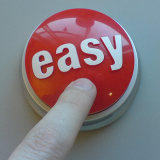 In computing as in everything else, the ease of use drives product adoption. We see this today with Apple — it’s decided that the most important thing about its products is that they MUST be as easy-to-use as humanly possible. Maybe even better than that. Steve Jobs is (in)famous for pushing his engineers beyond what they dreamt was possible. The iPad is what it is today because it’s ease of use makes it by far the best device on the market.
In computing as in everything else, the ease of use drives product adoption. We see this today with Apple — it’s decided that the most important thing about its products is that they MUST be as easy-to-use as humanly possible. Maybe even better than that. Steve Jobs is (in)famous for pushing his engineers beyond what they dreamt was possible. The iPad is what it is today because it’s ease of use makes it by far the best device on the market.
This isn’t a new trend; there are endless examples of this in history. Look at the TV dinner. Swanson had a huge surplus of frozen turkeys due to awful Thanksgiving sales one year, and turned them into the simplest three-part meal the world had ever seen. Put an aluminum tray in the oven for 25 minutes, and BAM! you have a complete dinner. They expected to sell about 5,000 of them during the first year on the market. They wound up selling more than ten million of them in the first year alone. The market grew and grew, and is now worth some $40 billion a year. Why? It’s the easiest dinner you can buy.
The invention of CDs revolutionized the markets for music. Why? Not because they were higher quality. Audiophiles today still claim that the vinyl record makes a better quality recording than a CD. People weren’t excited about the lighter weight of CDs. They were excited because you could instantly skip around the CD, listening to songs at random. People loved that you didn’t have to rewind the tape or re-place the needle anymore. Know what happened? CDs helped the industry nearly double music sales, shipping over 700 million units a year in 1995.
Now, I’m not trying to say that the ease of use is the only important thing about a product — far from it. Even if your product has a perfect UI, nobody will buy it if they don’t know about it. Having marketers that know what they’re doing is, well, important. And having engineers that can make a product work well is important too. Apple has a sensational marketing team and a world-class engineering team. Swanson copied the frozen meal idea from food on airplanes, but sold ten million of them with the name “TV Dinner,” piggybacking on television’s vast popularity at the time.
Sources: Wikipedia on TV dinners and CDs, and a Food Service News article.
Phil, how interesting you are! Keep posting!